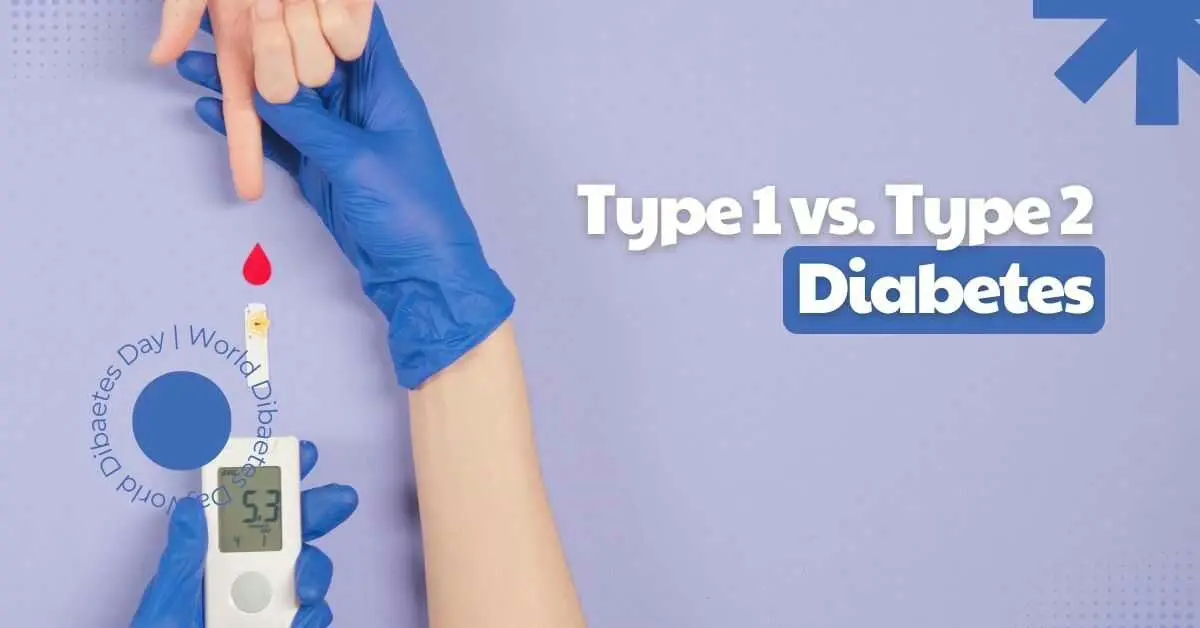Type 1 and Type 2 Diabetes: Key Differences, Symptoms, and Treatment

Hey there! Understanding the differences between Type 1 and Type 2 Diabetes is crucial, as they are two distinct conditions that affect how your body handles sugar. Diabetes is a significant health issue faced by many people, not just in India but also in places like the U.S.
A lot of folks get mixed up between Type 1 and Type 2 diabetes, but it’s really important to know the difference. If you know which one you have, you can take better care of yourself and be more careful.
Let’s look at some numbers: India: More than 77 million adults have diabetes. That’s a lot! U.S.: About 37 million people have it, and surprisingly, almost 1 in 5 don’t even know they have it.
Diabetes isn’t just about cutting out sweets. It’s a serious thing that can mess up your whole body. If you don’t keep it in check, it can lead to heart trouble, kidney problems, nerve pain, and even blindness. But don’t worry! With the right treatment and some changes in your daily life, you can still live a healthy and active life.
In this article, we’ll talk about: ✔ What diabetes is and how it affects our body ✔ The causes, symptoms, and risk factors of Type 1 and Type 2 diabetes ✔ The main differences between the two types ✔ How to treat diabetes and some tips to manage it
So, let’s start by understanding what diabetes really is and how it impacts our body.
Alright! Let’s break it down in a simple way.
Table of contents
What Is Diabetes?
Diabetes is a long-term problem that happens when your body can’t control the sugar levels in your blood. Sugar, or glucose, is what gives us energy. It comes from the food we eat. Normally, a thing called insulin, made by the pancreas, helps sugar get into our body’s cells to give us energy.
But in diabetes, either the body doesn’t make enough insulin or can’t use it properly. This makes the sugar levels in the blood go too high, and if we don’t manage it, it can cause big health problems.
How Does Insulin Work?
- You eat food → The food turns into sugar.
- Sugar goes into the blood → Blood sugar levels go up.
- Pancreas makes insulin → Insulin helps sugar get into cells for energy.
- Blood sugar levels go down → The body gets the right amount of energy.
In diabetes, this process doesn’t work right, and too much sugar stays in the blood. Over time, this can damage different parts of the body.
Types of Diabetes
There are different types of diabetes, but the main ones are:
1. Type 1 Diabetes
- Cause: Your body’s immune system attacks the cells that make insulin.
- Effect: The body stops making insulin completely.
- Management: People with Type 1 diabetes need insulin injections every day to stay healthy.
2. Type 2 Diabetes
- Cause: The body doesn’t use insulin properly.
- Effect: Blood sugar levels stay high because insulin isn’t working well.
- Management: You can control it with a good diet, exercise, and sometimes medicines.
3. Gestational Diabetes (During Pregnancy)
- Cause: Hormones during pregnancy can make blood sugar go high.
- Effect: It usually goes away after the baby is born, but it can increase the risk of Type 2 diabetes later.
Why Is High Blood Sugar Dangerous?
If diabetes isn’t controlled, high blood sugar can damage different parts of the body. Some problems include:
✔ Heart disease: High blood sugar can cause heart attacks and strokes. ✔ Kidney failure: Diabetes is a big cause of kidney problems. ✔ Eye problems: It can make your vision blurry and even cause blindness. ✔ Nerve damage: It can cause tingling, pain, or loss of feeling in the feet.
Who Is at Risk?
Anyone can get diabetes, but some people are more likely to get it. Things that increase the risk are:
- Family history (If your parents or siblings have diabetes)
- Being overweight or obese
- Unhealthy diet (Eating too much sugar and junk food)
- Not exercising enough
- High blood pressure and cholesterol
Can Diabetes Be Cured?
Right now, there is no permanent cure for diabetes. But with the right care, people with diabetes can live a normal and healthy life. People with Type 1 diabetes need insulin for life, while Type 2 diabetes can often be managed with lifestyle changes and medicines.
Sure! Let’s make it simple and easy to understand.
Type 1 Diabetes: Causes, Symptoms, and Risk Factors
What Is Type 1 Diabetes?
Type 1 diabetes is a serious problem where your body’s immune system attacks the cells in the pancreas that make insulin. Because of this, the pancreas stops making insulin completely. Without insulin, sugar can’t get into your cells, and your blood sugar levels go too high.
Type 1 diabetes is also called insulin-dependent diabetes or juvenile diabetes because it often starts in kids and young adults. But it can happen at any age. Unlike Type 2 diabetes, Type 1 is not caused by eating too much sugar or not exercising. It’s an autoimmune disease, which means your body’s immune system is attacking its own healthy cells.
Causes of Type 1 Diabetes
We don’t know exactly what causes Type 1 diabetes, but scientists think it’s a mix of genes and things in the environment.
- Immune System Attack: Your body’s immune system attacks the cells in the pancreas that make insulin.
- Genetics: If your mom, dad, or sibling has Type 1 diabetes, you’re more likely to get it.
- Viral Infections: Some viruses, like Coxsackievirus, can trigger the immune system to attack the pancreas.
- Environmental Factors: Some chemicals or toxins might increase the risk.
Remember, Type 1 diabetes is not caused by eating too much sugar or having an unhealthy lifestyle. It happens because your immune system isn’t working right.
Symptoms of Type 1 Diabetes
The symptoms of Type 1 diabetes come on quickly, usually within a few weeks. If it’s not treated, it can lead to a serious problem called diabetic ketoacidosis (DKA).
Common Symptoms:
- Excessive thirst: Always feeling thirsty.
- Frequent urination: Needing to pee a lot, especially at night.
- Extreme hunger: Feeling very hungry even after eating.
- Unexplained weight loss: Losing weight without trying.
- Tiredness and weakness: Feeling very tired for no reason.
- Blurred vision: Trouble seeing clearly.
- Slow healing of cuts and wounds: Cuts taking longer to heal.
- Fruity-smelling breath: A sign of ketoacidosis.
If you or someone you know has these symptoms, go see a doctor right away. Early diagnosis and treatment are very important to avoid serious problems.
Risk Factors for Type 1 Diabetes
Anyone can get Type 1 diabetes, but some people are more likely to get it.
Major Risk Factors:
- Family history: If your mom, dad, or sibling has Type 1 diabetes, you’re more at risk.
- Genetics: Some genes make you more likely to get diabetes.
- Age: It’s more common in kids and young adults, but it can happen at any age.
- Geography: People living in colder places have a higher risk.
- Viral infections: Some viruses can trigger the immune system to attack the pancreas.
Type 1 diabetes can’t be prevented because it’s caused by the immune system going wrong. But researchers are looking for ways to stop it from getting worse in people who are at high risk.
How Is Type 1 Diabetes Diagnosed?
Doctors use these tests to check for Type 1 diabetes:
1️⃣ Fasting Blood Sugar Test: Checks your blood sugar after not eating for 8 hours.
2️⃣ HbA1c Test: Shows your average blood sugar levels over the past 2-3 months.
3️⃣ Random Blood Sugar Test: Checks your blood sugar at any time of the day.
4️⃣ Autoantibody Test: Looks for markers that show the immune system is attacking insulin-making cells.
If you’re diagnosed, you need to start treatment right away to control your blood sugar and avoid complications.
Type 1 diabetes is a lifelong condition that needs careful management. Since the body stops making insulin, people with Type 1 diabetes need to take insulin injections every day.
Type 2 Diabetes: Causes, Symptoms, and Risk Factors
What Is Type 2 Diabetes?
Type 2 diabetes is the most common type of diabetes. It affects lots of people all over the world. In this condition, the body doesn’t use insulin properly, and blood sugar levels go too high. This happens because of something called insulin resistance, where the body’s cells don’t respond well to insulin.
At first, the pancreas tries to make extra insulin to keep up, but over time, it can’t make enough, and blood sugar levels stay high. Unlike Type 1 diabetes, which happens quickly, Type 2 diabetes develops slowly over many years. It’s often found in adults, but now even young people and teenagers are getting it because of changes in lifestyle.
Causes of Type 2 Diabetes
We don’t know the exact cause of Type 2 diabetes, but it’s strongly linked to how we live and our family history.
- Insulin Resistance: The body’s cells don’t respond well to insulin, so blood sugar goes up.
- Pancreas Can’t Keep Up: Over time, the pancreas can’t make enough insulin to control blood sugar.
- Genetics: If your parents or siblings have diabetes, you’re more likely to get it.
- Obesity: Being overweight makes it harder for insulin to work.
- Not Enough Exercise: Sitting around a lot and not exercising makes it harder for the body to use insulin.
- Unhealthy Diet: Eating too much junk food, sugary drinks, and processed carbs can lead to weight gain and insulin resistance.
- Hormonal Changes: Conditions like polycystic ovary syndrome (PCOS) can increase the risk of diabetes.
Unlike Type 1 diabetes, Type 2 diabetes can be prevented or delayed by living a healthy life.
Symptoms of Type 2 Diabetes
The symptoms of Type 2 diabetes come on slowly and might not be noticed for a long time. Many people don’t know they have diabetes until they get a routine check-up.
Common Symptoms:
- Frequent Urination: Waking up at night to pee a lot.
- Increased Thirst: Always feeling thirsty.
- Unexplained Weight Loss: Losing weight without trying.
- Tiredness and Fatigue: Feeling weak and low on energy.
- Blurred Vision: Trouble seeing clearly.
- Slow Healing of Wounds: Cuts and infections take longer to heal.
- Tingling or Numbness: In hands and feet due to nerve damage.
- Frequent Infections: Skin, gums, or urinary tract infections.
Since Type 2 diabetes develops slowly, many people ignore these symptoms or think they’re just signs of aging or stress. Regular health check-ups are important to catch diabetes early.
Risk Factors for Type 2 Diabetes
Several things can increase your risk of getting Type 2 diabetes.
Major Risk Factors:
- Family History: If a close family member has diabetes, you’re more at risk.
- Age: The risk goes up after age 40, but younger people are also at risk now.
- Obesity: Being overweight makes insulin resistance worse.
- Not Enough Physical Activity: Sitting for long hours and not exercising can lead to diabetes.
- Unhealthy Diet: Eating too much sugar, fried foods, and processed carbs.
- High Blood Pressure and Cholesterol: These conditions increase the risk of diabetes.
- Polycystic Ovary Syndrome (PCOS): Women with PCOS are more likely to get diabetes.
- History of Gestational Diabetes: Women who had diabetes during pregnancy are more likely to get Type 2 diabetes later.
The good news is that Type 2 diabetes can be prevented or delayed with the right lifestyle changes.
How Is Type 2 Diabetes Diagnosed?
Doctors use simple blood tests to check for Type 2 diabetes:
- Fasting Blood Sugar Test: Checks blood sugar levels after not eating for 8 hours.
- HbA1c Test: Shows the average blood sugar level over the past 2-3 months.
- Oral Glucose Tolerance Test (OGTT): Checks blood sugar before and after drinking a sugary drink.
- Random Blood Sugar Test: Checks blood sugar at any time of the day.
If the tests show high blood sugar levels, the doctor will confirm diabetes and suggest a treatment plan.
Type 2 diabetes is a growing problem, especially in India, where people eat high-carb diets and lead less active lifestyles. But the good news is that it can be prevented or controlled with a healthy diet, regular exercise, and medication if needed.
Alright! Let’s break it down in a simple way.
Key Differences Between Type 1 and Type 2 Diabetes
Diabetes is a big health problem that affects lots of people all over the world. Type 1 and Type 2 diabetes have some common symptoms, but they are two different diseases with different causes, treatments, and risk factors.
In this section, we’ll talk about the main differences between Type 1 and Type 2 diabetes to help you understand them better.
1. Basic Definition and Causes
| Feature | Type 1 Diabetes | Type 2 Diabetes |
|---|---|---|
| What it is | Autoimmune disease | Metabolic disorder |
| Cause | Immune system attacks insulin-making cells in the pancreas | Body becomes resistant to insulin or doesn’t make enough insulin |
| Insulin Production | Pancreas makes little or no insulin | Pancreas still makes insulin, but the body doesn’t use it properly |
| Main Risk Factor | Genetic and autoimmune factors | Lifestyle, diet, obesity, and genetic factors |
2. Age of Onset
| Feature | Type 1 Diabetes | Type 2 Diabetes |
|---|---|---|
| When it develops | Usually in childhood or teenage years (before 30) | Usually in adults (after 40), but now common in young people too |
| How it develops | Suddenly, with fast symptoms | Slowly, sometimes without noticeable symptoms |
Explanation: Type 1 diabetes is mostly found in children and teenagers, but Type 2 diabetes is usually found in adults over 40. However, because of unhealthy lifestyles and poor diets, more young people are now getting Type 2 diabetes.
3. Symptoms
| Feature | Type 1 Diabetes | Type 2 Diabetes |
|---|---|---|
| Common Symptoms | Frequent urination, extreme thirst, weight loss, fatigue, blurred vision | Frequent urination, excessive thirst, slow wound healing, numbness in hands/feet |
| Speed of Symptoms | Appears quickly, within weeks | Develops slowly over months or years |
Explanation: The symptoms of Type 1 diabetes come on suddenly and need quick medical attention, while Type 2 diabetes symptoms come on slowly and might not be noticed for years.
4. Risk Factors
| Feature | Type 1 Diabetes | Type 2 Diabetes |
|---|---|---|
| Genetics | Strong genetic link but not lifestyle-related | Genetic and lifestyle factors increase the risk |
| Lifestyle | Not related to diet or exercise | Poor diet, lack of exercise, and obesity increase the risk |
| Obesity | Not a risk factor | Major risk factor |
Explanation: Type 1 diabetes is caused by an autoimmune reaction and is not linked to obesity or lifestyle. Type 2 diabetes is mainly caused by poor lifestyle choices, like eating too much junk food, not exercising, and being overweight.
5. Treatment and Management
| Feature | Type 1 Diabetes | Type 2 Diabetes |
|---|---|---|
| Treatment | Insulin injections for life | Lifestyle changes, oral medication, and sometimes insulin |
| Can it be reversed? | No, it is permanent | Yes, with a healthy diet and exercise |
| Role of Diet & Exercise | Important for managing blood sugar but cannot cure it | Can prevent and even reverse the disease |
Explanation: People with Type 1 diabetes must take insulin injections for their whole life. But Type 2 diabetes can be controlled and even reversed by eating healthy, exercising, and staying fit.
6. Complications
Both Type 1 and Type 2 diabetes can lead to serious health problems if not managed properly.
| Feature | Type 1 Diabetes | Type 2 Diabetes |
|---|---|---|
| Heart Disease | High risk | High risk |
| Kidney Damage | High risk | High risk |
| Nerve Damage | Common | Common |
| Eye Problems | Can cause blindness | Can cause blindness |
| Amputation (due to infections) | Possible | Possible |
Explanation: Both types of diabetes increase the risk of heart disease, kidney failure, nerve damage, and blindness. That’s why it’s important to check blood sugar levels regularly and follow the right treatment.
7. Prevention
| Feature | Type 1 Diabetes | Type 2 Diabetes |
|---|---|---|
| Can it be prevented? | No, because it is an autoimmune disease | Yes, through a healthy lifestyle |
| Best Prevention | No prevention methods available | Eating healthy, exercising regularly, and maintaining a healthy weight |
Explanation: There is no way to prevent Type 1 diabetes, as it happens due to genetic and autoimmune factors. But Type 2 diabetes can be prevented by eating a balanced diet, avoiding sugary foods, exercising, and staying fit.
8. Summary of Key Differences
- Type 1 diabetes is an autoimmune disease, while Type 2 diabetes is caused by insulin resistance.
- One requires lifelong insulin treatment in Type 1 diabetes, whereas Type 2 diabetes can be managed or reversed through diet and exercise.
- Type 1 diabetes mostly affects children, while Type 2 diabetes is more common in adults but is increasing in young people.
- One can develop Type 1 Diabetes suddenly, whereas Type 2 diabetes develops slowly and may not show symptoms for years.
- Prevention of Type 1 diabetes is not possible, but Type 2 diabetes can be prevented with a healthy lifestyle.
Understanding the difference between Type 1 and Type 2 diabetes is important for managing the condition properly. While both types require careful blood sugar control, you can often prevent or reverse Type 2 diabetes through lifestyle changes, making these changes very important.”
If you or someone you know is at risk of diabetes, talk to a doctor for proper guidance. Early diagnosis and treatment can help prevent serious complications.
Treatment and Management of Diabetes: Best Practices
Diabetes is a lifelong condition, but with the right treatment and lifestyle changes, people can live a healthy and active life. The management of diabetes depends on whether a person has Type 1 or Type 2 diabetes. In this section, we will discuss the best ways to treat and manage diabetes to maintain normal blood sugar levels and prevent complications.
1. Treatment for Type 1 Diabetes
While Type 1 diabetes can’t be cured or reversed, you can manage it effectively with the right treatment plan.
A. Insulin Therapy
✔ Insulin injections or an insulin pump are necessary for survival.
✔ There are different types of insulin, including:
- Rapid-acting insulin (works within minutes)
- Short-acting insulin (works within an hour)
- Intermediate-acting insulin (lasts for 12-18 hours)
- Long-acting insulin (controls blood sugar for 24 hours)
B. Blood Sugar Monitoring
✔ People with Type 1 diabetes need to check their blood sugar levels several times a day using a glucometer or a continuous glucose monitor (CGM).
✔ This helps in adjusting insulin doses and avoiding high or low blood sugar levels.
C. Healthy Diet
✔ While diet alone cannot control Type 1 diabetes, eating healthy foods helps maintain stable blood sugar levels.
✔ It is important to avoid high-sugar foods and consume fiber-rich vegetables, whole grains, and lean proteins.
D. Exercise
✔ Regular exercise helps improve insulin sensitivity, but people with Type 1 diabetes should monitor their blood sugar before and after exercise to prevent low blood sugar (hypoglycemia).
E. Lifestyle Adjustments
✔ Stress management, proper sleep, and regular doctor visits are essential for effective diabetes control.
2. Treatment for Type 2 Diabetes
Unlike Type 1 diabetes, you can often reverse Type 2 diabetes with the right lifestyle changes. However, some people may still need medications or insulin if their blood sugar isn’t controlled.
A. Lifestyle Changes (Best Way to Reverse Type 2 Diabetes)
1️⃣ Healthy Diet
- Eat low-carb, high-fiber foods (whole grains, vegetables, lentils).
- Avoid sugary foods, processed foods, and deep-fried snacks.
- Drink plenty of water and avoid sugary drinks like soda and juices.
2️⃣ Regular Exercise
- Walking, jogging, yoga, and strength training can help lower blood sugar naturally.
- Aim for 30-60 minutes of exercise daily to improve insulin sensitivity.
3️⃣ Weight Management
- Losing even 5-10% of body weight can significantly lower blood sugar levels.
4️⃣ Managing Stress
- Meditation, deep breathing, and yoga help in reducing stress, which improves diabetes control.
5️⃣ Proper Sleep
- Sleeping for 7-9 hours per night helps maintain hormonal balance and blood sugar levels.
B. Medications for Type 2 Diabetes
If lifestyle changes are not enough, doctors may prescribe oral medicines such as: ✔ Metformin – Lowers blood sugar and improves insulin sensitivity. ✔ Sulfonylureas – Helps the pancreas release more insulin. ✔ SGLT2 inhibitors – Helps remove excess sugar through urine. ✔ GLP-1 receptor agonists – Slows digestion and lowers sugar levels.
C. Insulin Therapy for Type 2 Diabetes
✔ In some cases, oral medications are not enough, and doctors may prescribe insulin injections.
D. Regular Blood Sugar Monitoring
✔ People with Type 2 diabetes should check their blood sugar levels daily, especially if they are on medications.
3. Preventing Diabetes Complications
Both Type 1 and Type 2 diabetes can lead to serious health issues if not controlled properly. Here are some important tips to prevent complications:
- Control blood sugar levels – Keep your sugar levels within the normal range (fasting: 80-130 mg/dL, after meals: below 180 mg/dL).
- Maintain blood pressure and cholesterol – High BP and cholesterol can lead to heart diseases.
- Get regular eye checkups – Diabetes can cause blindness if not treated early.
- Take care of your feet – Diabetes can cause nerve damage, leading to foot infections and amputations.
- Avoid smoking and alcohol – Both can worsen diabetes and damage internal organs.
4. Is it possible to reverse Type 2 diabetes?
- Yes! Many people with Type 2 diabetes can reverse their condition by making strict lifestyle changes.
- Following a healthy diet, losing weight, exercising, and reducing stress can help bring blood sugar levels back to normal without medications.
- However, if you don’t manage diabetes early, it may become permanent and need lifelong treatment.
5. When to See a Doctor?
- When you are experiencing high blood sugar symptoms (extreme thirst, frequent urination, unexplained weight loss).
- If you have low blood sugar symptoms (shaking, sweating, dizziness, confusion).
- When your blood sugar levels remain too high or too low, even with medication.
- When you notice foot ulcers, vision problems, or slow-healing wounds.
- For regular diabetes checkups to monitor your overall health.
Managing diabetes requires discipline and commitment, but it is completely possible to live a normal life with the right treatment.
- For Type 1 diabetes, insulin therapy, blood sugar monitoring, and a balanced lifestyle are key.
- For Type 2 diabetes, healthy eating, weight loss, and exercise can reverse the disease and avoid medications.
The earlier you take action, the better your health will be! If you or a loved one has diabetes, start making small changes today to live a healthier and happier life. 😊
Frequently Asked Questions (FAQs)
No, Type 1 diabetes and Type 2 diabetes are two different diseases. Type 1 diabetes is an autoimmune disease where the body stops making insulin. Lifestyle changes can help you manage Type 2 diabetes, which is caused by insulin resistance. One type does not turn into the other, but both need careful management.
Yes, Type 2 diabetes is reversable with the right lifestyle changes. Eating a healthy diet, losing weight, exercising regularly, and managing stress can help bring blood sugar levels back to normal. But, if you dont manage diabetes early, it can become permanent and require lifelong treatment.
The best diet for diabetes management includes:
Low-carb, high-fiber foods: Whole grains, vegetables, and lentils.
Lean proteins: Chicken, fish, and legumes.
Healthy fats: Nuts, seeds, and olive oil.
Avoid sugary foods: Limit sweets, processed foods, and sugary drinks.
Stay hydrated: Drink plenty of water.
Conclusion
Key Differences
- Type 1 Diabetes: An autoimmune disease where the body stops making insulin. Requires lifelong insulin injections.
- Type 2 Diabetes: Caused by insulin resistance. You can often manage or reverse it with lifestyle changes, diet, and exercise.
Regular Health Checkups
Regular health checkups are crucial for early detection and management of diabetes. They help in maintaining healthy blood sugar levels and preventing complications.
Consult a Doctor for Personalized Advice
If you or someone you know is at risk of diabetes or has symptoms, consult a doctor for personalized advice. Early diagnosis and treatment can make a big difference in managing diabetes and living a healthy life.
Stay proactive about your health! If you have any questions or need further guidance, don’t hesitate to reach out to a healthcare professional. Your health is in your hands!




